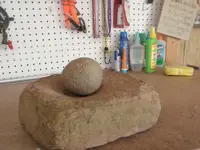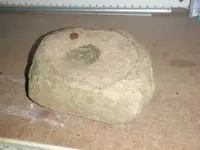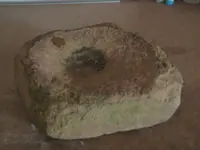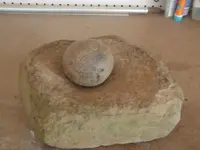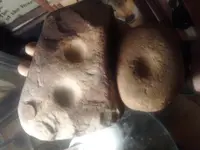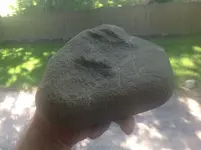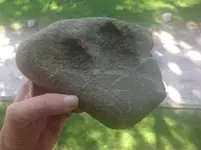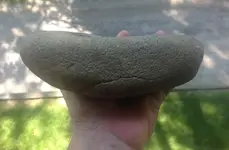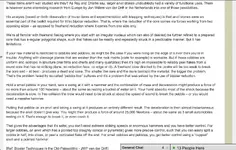Please read the photographed passage I posted in my last comment for an explanation of a certain class of pitted stones, of which so- called nutting stones are but one type.
sorry for the screwup. Took over 2 hours, but I was finally able to cut and paste describing how a certain type of these pitted stones were used, and it was not for nuts in all instances. Geez, 2 hours plus, I'm going back to bed. LOL....
"These items aren’t well studied are they? As Ray and Charlie say, larger anvil stones undoubtedly had a variety of functional uses. There is however some interesting research from Europe by Jan Willem van der Drift in the Netherlands into one of those possibilities.
His analysis (based on both observation of found items and experimentation with knapping techniques) is that anvil stones were an essential part of the toolkit required for lithic bipolar reduction. That is, where the reduction of the core comes via forces working from two opposing sides – as opposed to freehand reduction where it comes from one side only.
We’re all familiar with freehand flaking where you start with an irregular nucleus which can also (if desired) be further refined to a prepared core that has a regular polygonal shape, such that flakes can be readily and repeatedly struck in a predictable manner. But it has limitations.
If your raw material is restricted to cobbles and pebbles, as might be the case if you were living on the edge of a river then you’re in trouble. Anything with cleavage planes that are weaker than the rock matrix (slate for example) is workable. But if those cobbles are uniform and isotropic in structure (like flints and cherts and many quartzites) then it’s nigh on impossible to reliably peel flakes from a round core that has no striking plane, no reduction face, no edge or rib. A freehand blow directed to the centre will be too weak to break the core and – at best - produces a dead end cone. The smaller the core and the more isotropic the material, the bigger the problem. That’s the problem faced by so-called “pebble-tool” cultures and it’s a problem that was solved by the use of bipolar reduction.
Hold a small pebble in your hand, take a swing at it with a hammer and the combination of mass and deceleration might produce a force of no more than around 100 Newtons – about the same as resting a bucket of water on it. Your hand absorbs most of the shock because the deceleration is slow. In free collision the blow would need to be struck at about the speed of sound to break the pebble – or you would need a massive hammer.
Putting that pebble on an anvil and taking a swing at it produces an entirely different result. The deceleration is then almost instantaneous because the anvil doesn’t give way. You might then produce a force of around 25,000 Newtons – about the same as 3 small automobiles resting on it. That’s enough to break it, or even crush it.
That gives the advantages that it’s safer, you don’t need extreme striking speeds or enormous hammers and you have better control. For larger cobbles, an anvil which has a pointed top (roughly conical or pyramidal) gives more precise control, such that you can easily split a cobble in half, into slices, or peel a corticated flake off the end. For small cobbles and pebbles, you get better control using a “cupped” anvil and a pointed hammer."
